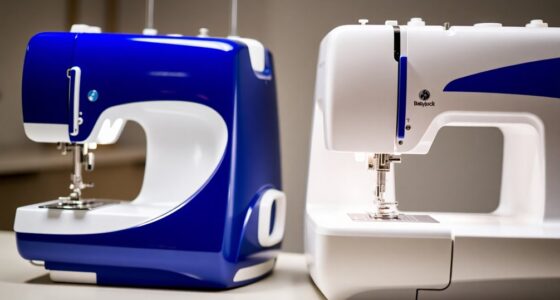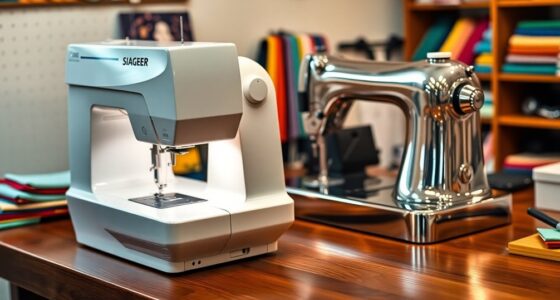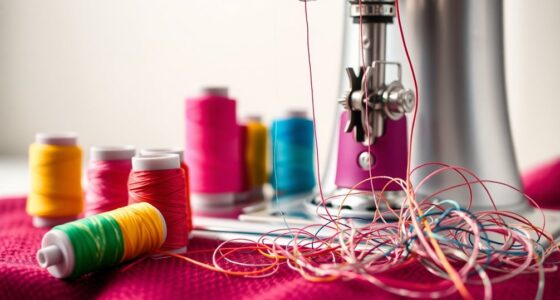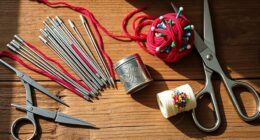To sharpen a seam ripper, use 000-grade steel wool wrapped around a pencil or crochet hook. Hold the seam ripper steady and gently move the wool against the blade while keeping the original cutting angle. You can also use a bead reamer or sandpaper for effective sharpening. Regular maintenance, like cleaning the blade and applying oil, will keep your seam ripper performing well. If you're curious about more sharpening techniques and tips, keep exploring!
Key Takeaways
- Wrap 000-grade steel wool around a pencil or crochet hook to sharpen the seam ripper effectively.
- Hold the seam ripper steady and move the wrapped tool upward against the blade gently.
- Maintain the original cutting angle while sharpening for optimal results.
- Test the sharpness on a scrap piece of fabric after sharpening to ensure effectiveness.
- Clean the blade with rubbing alcohol and apply oil for smoother gliding and maintenance.
Understanding the Importance of a Sharp Seam Ripper
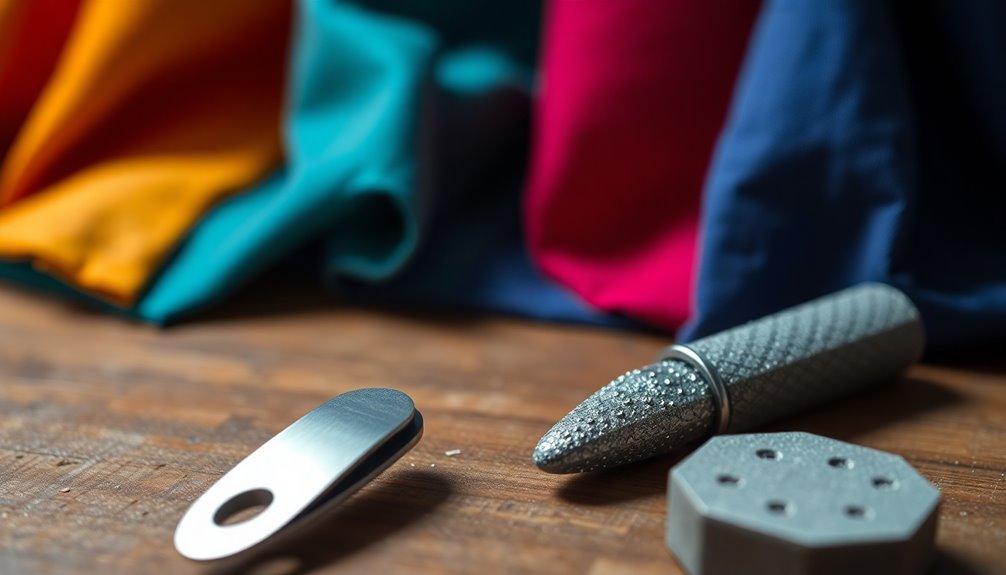
When you're tackling a sewing project, having a sharp seam ripper is essential for efficiency and precision. A dull seam ripper can lead to frustration, making it harder to remove stitches cleanly and increasing the time you spend on tasks.
By sharpening seam rippers regularly, you guarantee they remain effective for efficiently removing stitches without damaging your fabric. This not only enhances your overall performance but also reduces the risk of accidental fabric snags.
Additionally, proper maintenance helps extend the lifespan of a seam ripper, saving you money on replacements. Ultimately, keeping your seam ripper sharp contributes to a more enjoyable quilting experience, allowing you to focus on your creativity instead of wrestling with ineffective tools.
Common Causes of Dullness
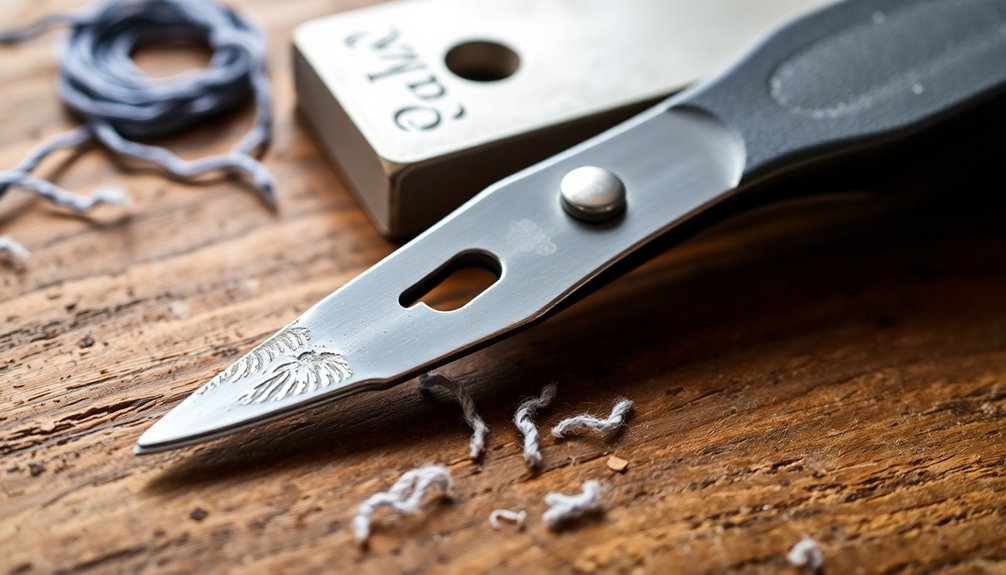
Your seam ripper can lose its edge for several reasons.
Frequent use, improper storage, and residue build-up can all contribute to dullness, making it less effective when you need it most.
Let's explore these common causes so you can keep your tool sharp and ready for action.
Frequent Usage Impact
Frequent use of a seam ripper can greatly impact its sharpness, making it prone to dullness over time. Removing stitches from thick fabrics can accelerate this process. To maintain your seam ripper, consider these factors:
| Cause of Dullness | Solution |
|---|---|
| Constant use | Periodic sharpening |
| Neglecting protective cap | Always use the protective cap |
| Corrosive residues | Regular cleaning with alcohol |
| Improper techniques | Use the correct angle and force |
Improper Storage Habits
Although seam rippers are essential tools for any sewing enthusiast, improper storage habits can quickly lead to dull blades.
Leaving your seam ripper exposed or without a protective cap invites accidental contact with other tools, causing nicks and dullness. Storing them in damp or humid conditions promotes rust, which greatly reduces their sharpness.
A crowded toolbox can also be detrimental; if your seam ripper jostles against other items, it might sustain damage.
Remember to regularly clean seam rippers after use to prevent any build-up that could affect their performance.
Finally, always replace the protective cap when you're done to keep the blades safe from unwanted harm.
Taking these steps will help maintain your seam ripper's effectiveness.
Residue Build-Up Issues
Even with proper storage, seam rippers can still become dull due to residue build-up. When you cut through fabric with thread, oils, or adhesives, the blades can accumulate sticky residue, leading to dulled performance.
Frequent exposure to substances like fabric glue or interfacing accelerates this issue. To keep your seam ripper sharp, regular cleaning with alcohol is essential; it helps remove residue and prevents corrosion, which contributes to dullness.
Also, remember to replace the protective cap after each use—failing to do so may lead to accidental contact with other materials, causing additional wear.
Maintaining your seam ripper through consistent cleaning after projects is vital for its longevity and effectiveness.
Effective Sharpening Methods

To sharpen your seam ripper effectively, try using 000-grade steel wool wrapped around a pencil or chopstick to refine the blade's edge.
If you're looking for alternative options, consider a bead reamer or emery board for precise sharpening.
These methods will help restore your tool's sharpness and keep your sewing projects on track.
Steel Wool Technique
When you need to bring your seam ripper back to life, the steel wool technique is an effective and straightforward method.
Start by wrapping 000-grade steel wool around a pencil or chopstick to create your sharpening tool.
Hold the seam ripper in your non-dominant hand and use your dominant hand to move the steel wool wrapped tool against the blade in an upward motion.
Remember to apply light pressure to help maintain the cutting edge angle, ensuring both sides of the blade are sharpened evenly.
- Extend the life of your seam ripper.
- Clean the blade with rubbing alcohol after sharpening.
- Regular maintenance prevents frequent replacements.
With these steps, your seam ripper will be sharp and ready for use!
Alternative Tools Options
While steel wool is a popular method for sharpening seam rippers, several alternative tools can effectively restore your blade's edge.
A bead reamer serves as a mini metal file; use it to gently abrade the blade at an angle for precision sharpening. Fine emery boards or small jewelry files offer careful maintenance, perfect for keeping that edge sharp.
You can also use sandpaper wrapped around a chopstick, providing a rough surface to restore sharpness quickly.
For a more advanced option, consider a Dremel tool with specialized sharpening stones, which can make the task effortless and efficient.
Experiment with these alternatives to find the method that works best for you and keeps your seam ripper in top shape.
Step-By-Step Guide to Sharpening With Steel Wool
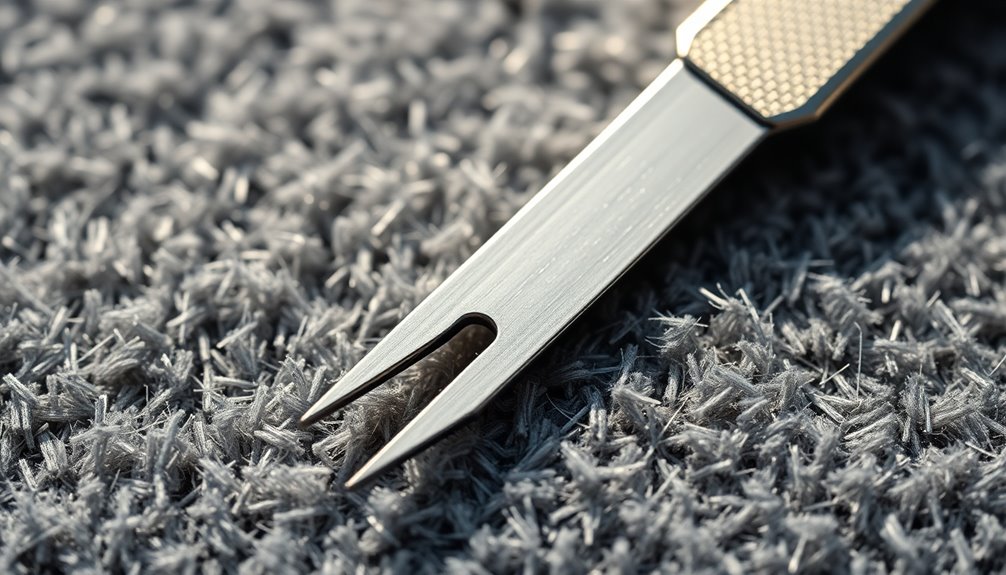
Sharpening your seam ripper with steel wool is a simple yet effective process that can restore its cutting efficiency.
Start by wrapping 000-grade steel wool around a pencil or crochet hook to create a makeshift sharpening tool.
- Hold the seam ripper firmly in your non-dominant hand for stability.
- With your dominant hand, move the pencil or crochet hook upward against the blade, applying gentle pressure.
- Maintain the original cutting angle to guarantee effective sharpening and prevent damage.
After you've sharpened both sides evenly, test the seam ripper's sharpness on a scrap piece of fabric.
This quick method will have your seam ripper cutting smoothly again in no time!
Utilizing a Bead Reamer for Sharpening
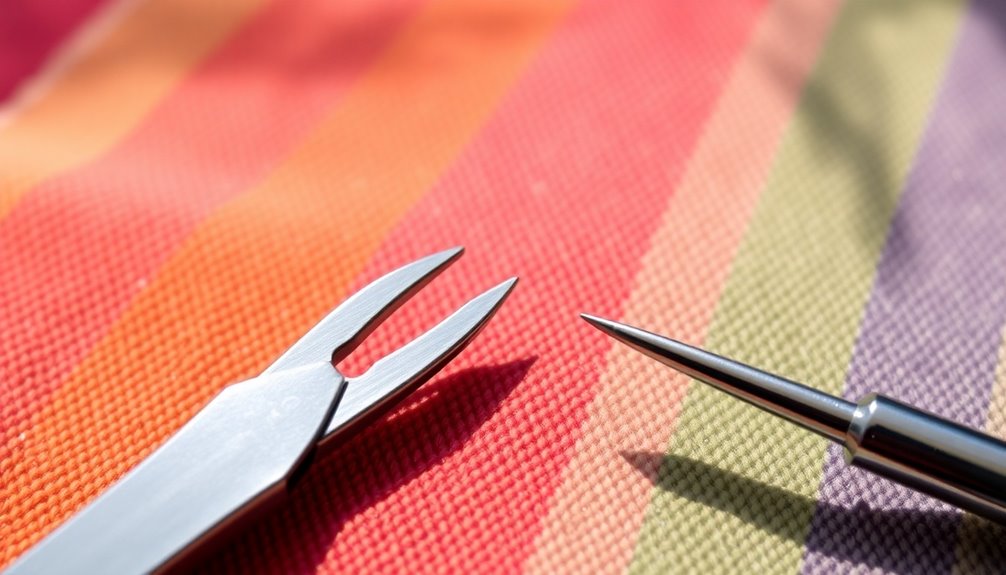
A bead reamer can be a handy tool for sharpening your seam ripper, offering precision much like a mini metal file.
To sharpen, hold the seam ripper in one hand and the bead reamer in the other. Apply gentle upward motions against the blade edge, ensuring you maintain the correct angle—typically around 20-30 degrees—for an effective and even edge.
After a few strokes, check the sharpness to gauge your progress. If the blade isn't sharp enough, continue sharpening until you achieve the desired result.
Once you’re satisfied, don’t forget about cleaning; use alcohol to remove any residue. This simple step will enhance your seam ripper’s longevity and keep it in top condition for future projects. Additionally, it’s important to store your seam ripper safely to prevent any accidental damage. If you’re working on projects that involve embellishments, you might also want to learn how to take off rhinestones properly, ensuring you don’t harm the fabric in the process. Taking these extra steps will not only protect your tools but also enhance the quality of your work.
Maintenance Tips for Prolonging Sharpness
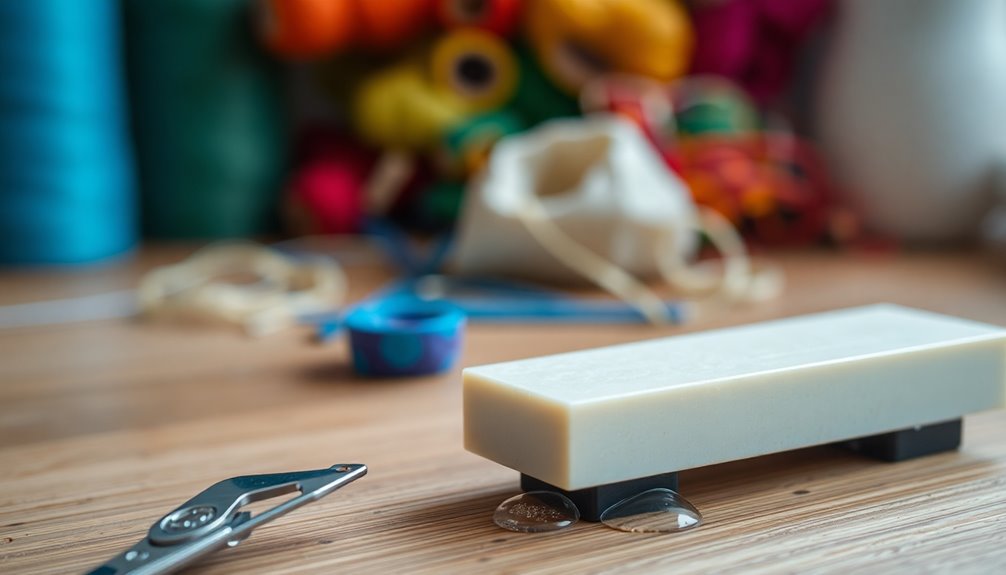
To keep your seam ripper performing at its best, maintenance is key. Regular care not only prolongs the sharpness of the blade but also enhances your sewing experience.
Here are some essential maintenance tips:
- Always replace the protective cap after use to prevent dullness.
- Clean the seam ripper with rubbing alcohol to remove residue.
- Periodically use steel wool or fine emery boards to hone the edge.
Before sharpening, apply a drop of oil to the blade. This helps with smoother gliding and more effective sharpening.
Frequently Asked Questions
How Do You Sharpen a Ripper?
To sharpen a ripper, you've got a few handy methods.
You can use fine steel wool wrapped around a pencil, moving it upward against the blade. A bead reamer works well too; just apply gentle upward motions.
If you prefer precision, try fine emery boards or small jewelry files.
Alternatively, cutting through layered aluminum foil can restore the edge.
Always clean with alcohol and add a drop of oil for best results before sharpening!
How to Sharpen Seam Ripper With Nail File?
To tackle the task of taming your seam ripper, you'll want a fine file.
First, firmly grasp the seam ripper in one hand. With the other, angle the emery board against the blade. Gently glide the blade along the file, keeping a consistent angle for a sharp slice.
Switch sides to sharpen symmetrically, ensuring an even edge. Finally, test your tool on a scrap fabric to feel the fantastic cutting finesse you've created!
How to Sharpen a Thread Picker?
To sharpen a thread picker, you can use 000-grade steel wool wrapped around a pencil. Move it against the blade at a consistent angle.
Alternatively, gently abrade the blade with a bead reamer in an upward motion, ensuring even sharpening on both sides.
For precision, fine emery boards or small jewelry files work well.
Remember to clean the blade with alcohol and oil it before sharpening to maintain its performance.
Test the sharpness afterward!
What Is the Red Ball for on a Seam Ripper?
Imagine trying to slice through fabric with a butter knife—frustrating, right?
The red ball on a seam ripper's tip serves a vital purpose. It keeps you safe by preventing accidental cuts while unpicking stitches. The rounded design helps you maneuver easily around seams, lifting the fabric to access threads better.
Plus, it enhances visibility, making it simpler to locate where you need to cut. It's an essential feature for any sewing project!
Conclusion
In the world of sewing, a sharp seam ripper is your trusty sword, cutting through fabric's defenses with ease. By understanding dullness's causes and employing effective sharpening methods like steel wool or a bead reamer, you can keep your tool ready for battle. Regular maintenance will guarantee it stays sharp, allowing you to tackle any sewing challenge that comes your way. So, keep that seam ripper honed, and conquer your projects with confidence!


